教师招聘英语面试语音课型实战篇修订稿
教师招聘面试英语语音知识
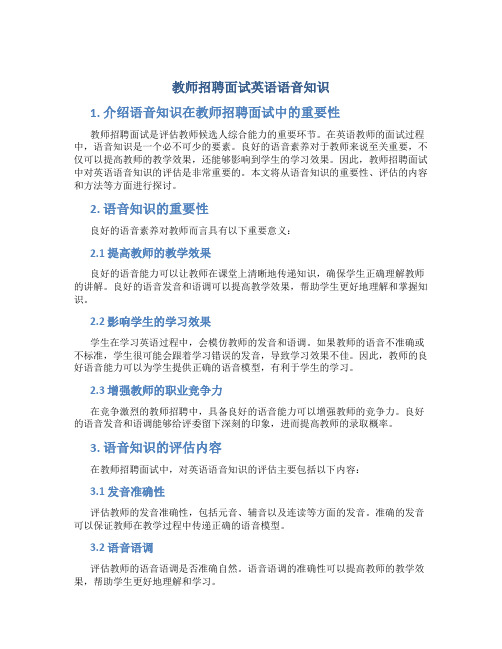
教师招聘面试英语语音知识1. 介绍语音知识在教师招聘面试中的重要性教师招聘面试是评估教师候选人综合能力的重要环节。
在英语教师的面试过程中,语音知识是一个必不可少的要素。
良好的语音素养对于教师来说至关重要,不仅可以提高教师的教学效果,还能够影响到学生的学习效果。
因此,教师招聘面试中对英语语音知识的评估是非常重要的。
本文将从语音知识的重要性、评估的内容和方法等方面进行探讨。
2. 语音知识的重要性良好的语音素养对教师而言具有以下重要意义:2.1 提高教师的教学效果良好的语音能力可以让教师在课堂上清晰地传递知识,确保学生正确理解教师的讲解。
良好的语音发音和语调可以提高教学效果,帮助学生更好地理解和掌握知识。
2.2 影响学生的学习效果学生在学习英语过程中,会模仿教师的发音和语调。
如果教师的语音不准确或不标准,学生很可能会跟着学习错误的发音,导致学习效果不佳。
因此,教师的良好语音能力可以为学生提供正确的语音模型,有利于学生的学习。
2.3 增强教师的职业竞争力在竞争激烈的教师招聘中,具备良好的语音能力可以增强教师的竞争力。
良好的语音发音和语调能够给评委留下深刻的印象,进而提高教师的录取概率。
3. 语音知识的评估内容在教师招聘面试中,对英语语音知识的评估主要包括以下内容:3.1 发音准确性评估教师的发音准确性,包括元音、辅音以及连读等方面的发音。
准确的发音可以保证教师在教学过程中传递正确的语音模型。
3.2 语音语调评估教师的语音语调是否准确自然。
语音语调的准确性可以提高教师的教学效果,帮助学生更好地理解和学习。
3.3 重音和语速评估教师的重音和语速是否合适。
恰当的重音和适宜的语速可以使教学更有节奏感,提高学生的学习兴趣和效果。
3.4 流利度评估教师的口语流利度。
流利的口语可以提高教师的表达能力和沟通能力,为教学提供更好的语言环境。
4. 评估方法在教师招聘面试中,可以采用以下方法对英语语音知识进行评估:4.1 朗读要求教师根据给定的材料进行朗读。
中学英语教师招聘面试全英文说课稿
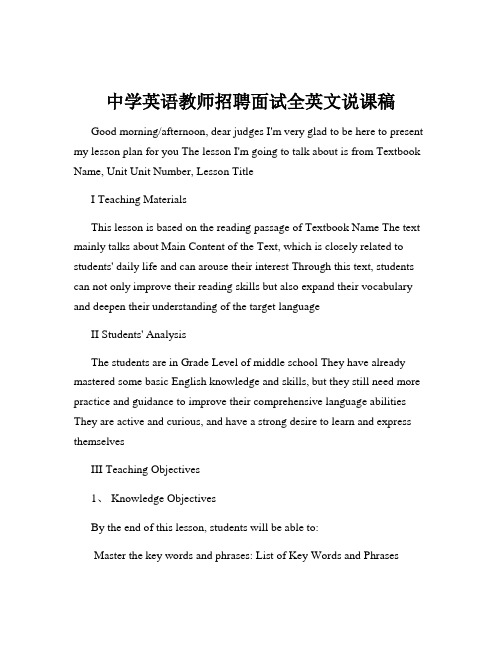
中学英语教师招聘面试全英文说课稿Good morning/afternoon, dear judges I'm very glad to be here to present my lesson plan for you The lesson I'm going to talk about is from Textbook Name, Unit Unit Number, Lesson TitleI Teaching MaterialsThis lesson is based on the reading passage of Textbook Name The text mainly talks about Main Content of the Text, which is closely related to students' daily life and can arouse their interest Through this text, students can not only improve their reading skills but also expand their vocabulary and deepen their understanding of the target languageII Students' AnalysisThe students are in Grade Level of middle school They have already mastered some basic English knowledge and skills, but they still need more practice and guidance to improve their comprehensive language abilities They are active and curious, and have a strong desire to learn and express themselvesIII Teaching Objectives1、 Knowledge ObjectivesBy the end of this lesson, students will be able to:Master the key words and phrases: List of Key Words and PhrasesUnderstand the main idea and details of the text2、 Skill ObjectivesImprove students' reading skills, such as skimming, scanning and detailed readingEnable students to express their opinions and ideas about the topic in English3、 Emotional ObjectivesCultivate students' interest in English learningHelp students form a positive attitude towards Related ThemeIV Teaching Key Points and Difficult Points1、 Teaching Key PointsMaster the key words, phrases and sentence structures in the textUnderstand the main idea and important details of the text2、 Teaching Difficult PointsAnalyze the text structure and summarize the main ideaUse the learned language knowledge to express their own thoughts and opinionsV Teaching MethodsIn this lesson, I will mainly adopt the following teaching methods:1、 Taskbased Language Teaching Method: I will design various tasks to help students complete the learning objectives step by step2、 Communicative Teaching Method: Encourage students to communicate and interact with each other in English to improve their language output ability3、 Situational Teaching Method: Create reallife situations to make the learning process more vivid and interestingVI Teaching AidsTo make the teaching process more effective and attractive, I will use the following teaching aids:1、 Multimedia: Use PPT, videos and audio materials to present the teaching content visually and auditorily2、 Blackboard and chalk: Write key points and summaries on the blackboard to help students better understand and rememberVII Teaching Procedures1、 Leadin (5 minutes)At the beginning of the class, I will show a short video or some pictures related to the topic to arouse students' interest and lead them into the new lesson Then, I will ask a few questions to stimulate students' thinking and have a simple discussion with them2、 Prereading (5 minutes)I will present some new words and phrases related to the text and explain their meanings and usage Then, I will ask students to predict the content of the text based on the title and pictures, which can help them activate their prior knowledge and lay a foundation for the following reading3、 Whilereading (15 minutes)Skimming: Ask students to read the text quickly and find out the main idea Then, check their answers and guide them to summarize the main idea in one sentenceScanning: Give students some specific questions and ask them to scan the text to find the answers After that, have them share their answers in pairs and correct them togetherDetailed Reading: Let students read the text carefully and analyze the text structure I will guide them to find the topic sentences of each paragraph and understand the logical relationship between paragraphs4、 Postreading (10 minutes)Group Discussion: Divide students into groups and ask them to discuss the following questions: List of Discussion Questions Encourage them to express their opinions and ideas freely, and then have representatives from each group present their discussionsSummary: Ask students to summarize what they have learned in this lesson, including key words, phrases, main idea and reading skills5、 Language Practice (10 minutes)Provide some exercises, such as multiplechoice questions, filling in the blanks and sentence transformation, to consolidate the language knowledge students have learned Check the answers and give feedback to students6、 Homework Assignment (5 minutes)Assign the following homework:Write a short passage about Related Topic based on the textRead the text again and review the key pointsVIII Blackboard DesignOn the left side of the blackboard, I will write the key words and phrases On the right side, I will summarize the main idea and text structure In the middle, I will leave some space for explanations and examplesThat's all for my lesson plan Thank you for listening。
(新)中小学英语教师招聘试讲稿万能模板
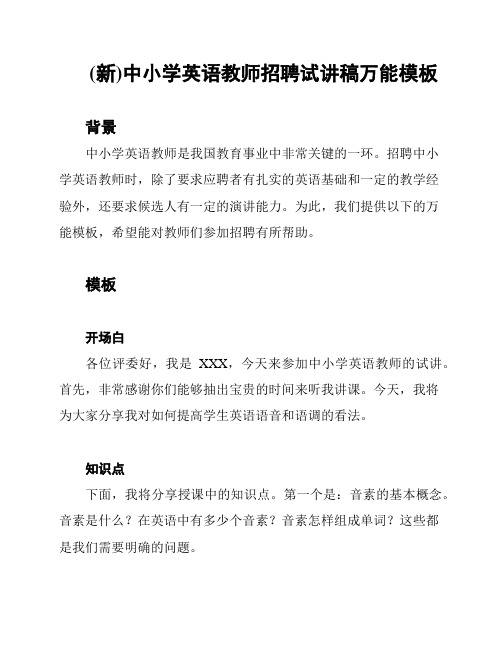
(新)中小学英语教师招聘试讲稿万能模板背景中小学英语教师是我国教育事业中非常关键的一环。
招聘中小学英语教师时,除了要求应聘者有扎实的英语基础和一定的教学经验外,还要求候选人有一定的演讲能力。
为此,我们提供以下的万能模板,希望能对教师们参加招聘有所帮助。
模板开场白各位评委好,我是XXX,今天来参加中小学英语教师的试讲。
首先,非常感谢你们能够抽出宝贵的时间来听我讲课。
今天,我将为大家分享我对如何提高学生英语语音和语调的看法。
知识点下面,我将分享授课中的知识点。
第一个是:音素的基本概念。
音素是什么?在英语中有多少个音素?音素怎样组成单词?这些都是我们需要明确的问题。
第二个知识点是:音标的基础知识。
在英语中,音素不仅有很多种,而且还有很多不同的音标来表示这些音素。
因此,我们需要了解这些音标,并能够正确的发音。
案例分析在授课中,实例非常重要。
下面我将为大家带来两个实际案例:第一个案例是:a和e的发音问题。
在英语中,a和e的发音很容易弄混,学生在研究中也难免会遇到这个问题。
那么,我们应该如何帮助学生正确发音?第二个案例是:语调的问题。
语调是英语研究中非常重要的一项内容。
但是,学生往往忽略了语调对于交流的影响。
因此,我们需要提醒学生注意语调问题。
总结今天,我为大家分享了提高学生英语语音和语调的方法。
我们需要了解音素和音标、及时纠正学生的发音错误、并且提高学生对于语调问题的认识。
最后,再次感谢各位的聆听。
2024教师招聘面试高中英语语音逐字稿

语音:题:A:you’re new here, aren’t you? (升调)B: Yes, I am. My name is Bill. You are Tony, aren’t you?(升调)A: That’s right.B: it’s really crowded here, isn’t it?(升调)A: yes, it is.针对划线部分的语调标记,进行相应的语音教学活动。
Warm up:Good morning, boys and girls! How are you today ? oh~ you are fine.I am fine too, thank you.1.Lead in:“Ok boys and girls, before the class, I’ll say a tongue twister, please listen to me carefully --Can you can a can as a canner can can a can? Can you do it”(ok, lily. I saw your hands. Please, stand up and show us your tongue twister.)Well done, now, let’s have a free talk.Do you know the word “phatic”? it means to great people when they first meet. So, here is a question: how do people usually great strangers? Lily, please. Great! “Did you eat?” that’s a Chinese way to say hello. Anyone else? Robin, ok, “How’s it going”. and most of the American say: “ what’s up”. people from different countries have different ways to start a chat.Today, we’ll learn how to great with correct tones (声调).2.PresentationStep 1: 理解材料Guys, please open your book.Now we have a short passages and please listen to the tape and thinkabout this question:who is the new comers here?Please listen carefully and try to give me the answer. Let’s begin.Ok time’s up. Please share your ideas. Jordan, you please. Thank you, sit down please. (Bill is the new one and tony is the first man he meet here). good job! You all get the right answer.Step 2: 呈现知识点All right guys, it’s time to learn something new. Here are some new sentences. Let’s look at the first one. Can you read it? Any volunteers? Yes, “you’re new here, aren’t you?” can anybody try again? Yes, that little girl. What about this one? Ok, this is “it’s really crowded here, isn’t it” and can anybody try again? Good.So did you find something different when they read? Yes, they used different tones. Why? Let’s see.Step3: 总结规律Ok, let’s strike when the iron is hot. We use Tag questions(附加、反意疑问句)when we great to others. How to use the tones when we read them? Please work with your desk mates and then iI’ll choose someone to share your ideas, ok?Time’s up. Who would like to try? Messi please. Ok, he said: “there are two parts in a tag question. The first part is a statement. The second part is a negative question”. Any other volunteers? Yes, Alice. She said: “we use falling tone in the first part and rising tone in the second part.”is she right? Yes, Fantastic ideas.3.PracticeActivity1 : 复习材料Practice makes perfect, let’s do more exercises then. There are two activities.First, let’s review the passage by marking the tones. Please finish it as quickly as you can and we will check the answers later. Here we go. / ok~ I need two students to come to the blackboard and mark the tones for us. Who can have a try? Ok~ how about Mike and Alice? you two please, come to the front. (写板书)Yes, i am.(下降) My name is Bill. (下降)You are Tony, (下降)aren’t you?(上升)Ok~ Have you finished? I think almost all of you have finished. now Let’s check. (The first sentence, are they right?) The first statement should use the falling tone and the second part should use the rising tone What’s the answer? Cool, any different opinions? All right, i think you have mastered it.Activity 2: 结对活动Now, let’s works in pairs to have more communication. Now suppose you are in a station to meet a new friend, or you want to meet a new friend with someone. How would you start a chat? Try to make a conversation and practice with your partner. Remember, try to use the new knowledge we learned today, clear? Ok, start.So, which team goes first? You two please. Great! Ok~you did a very good job.4.ProductionTask 1: 话题讨论“Do we usually say: there are a thousand Hamlets in a thousand people’s eyes. We have learned about different greetings t oday. Now let’s have a discussion. Think about it in this way: is it important to have tones in a language? Ok, ten minutes for you. Please work in your groups and share your ideas, then each group will choose one reporter to share your group opinion to us. Let’s see which group has the most creative idea, and which re porter talks more smoothly and clearly.Ok, time’s up. Which team goes first? Great job.Task 2: 配音练习Since we have mastered the knowledge well, let’s play a dubbing game. We will watch a movie. For the first time, listen to it carefully, and the second time it will be silent. You need to choose your own character, and try to make the scene as interesting as you can, all right? Then we will have a dubbing competition. Are you ready?Excellent, you all give wonderful performance, i am very proud of your progress and smart ideas.5.Summary and homeworkSummary: “how time flies! Who can tell me what we have learned today? Ok, I heard most of you say we have learned different ways of greeting. Great! And I also heard that we have learned how to use correct tones in a tag questions. Exactly! And don’t forget: learning English is not just inside the class. It’s for life, it’s for fun.”Homework:“ok, boys and girls. Class is almost over. And there is one last thing, what is it? Right, our homework! When you go home, please practice different tones first and search more information about different greetings on the internet. We will share them in the next class. So much for today, goodbye, everyone!”。
语音课真题+教案+逐字稿
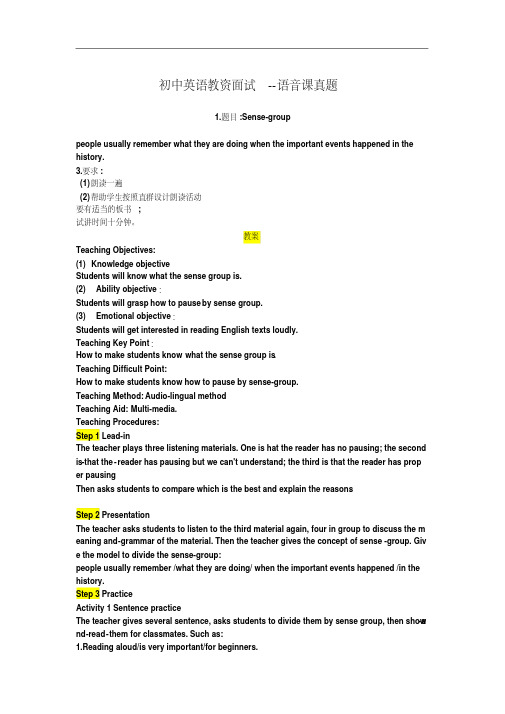
初中英语教资面试--语音课真题1.题目:Sense-grouppeople usually remember what they are doing when the important events happened in the history.3.要求:(1)朗读一遍(2)帮助学生按照直群设计朗读活动要有适当的板书;试讲时间十分钟。
教案Teaching Objectives:(1) Knowledge objectiveStudents will know what the sense group is.(2) Ability objective:Students will grasp how to pause by sense group.(3) Emotional objective:Students will get interested in reading English texts loudly.Teaching Key Point:How to make students know what the sense group is.Teaching Difficult Point:How to make students know how to pause by sense-group.Teaching Method:Audio-lingual methodTeaching Aid: Multi-media.Teaching Procedures:Step 1 Lead-inThe teacher plays three listening materials. One is hat the reader has no pausing; the second is-that the-reader has pausing but we can't understand; the third is that the reader has prop er pausingThen asks students to compare which is the best and explain the reasons.Step 2 PresentationThe teacher asks students to listen to the third material again, four in group to discuss the m eaning and-grammar of the material. Then the teacher gives the concept of sense -group. Giv e the model to divide the sense-group:people usually remember /what they are doing/ when the important events happened /in the history.Step 3 PracticeActivity 1 Sentence practiceThe teacher gives several sentence, asks students to divide them by sense group, then show-a nd-read-them for classmates. Such as:1.Reading aloud/is very important/for beginners.2 Early to bed/and early to rise/makes a man/healthy, happy, and-wiseActivity 2 Passage practiceStudents choose passages that they are interested in to read for classmates in competition.Step 4 Summary and HomeworkSummary: Ask students to conclude what they have learned in the class.Homework; Ask students to listen to a passage of VOA to consolidate how to pause by sense-group after-class.Blackboard Design:板书people usually remember /what they are doing/ when the important events happened/ in the history.语音课逐字稿Good morning,everyone, i am Miss XX. it’s my honor to participate this interview, now iwill begin my class.Good morning boys and girls, i am Miss X, today we will learn english together!How are you today? Ok ,good!In today’s phonetic class we will learn about sense group! Now ,i will read a sentence twice, and tell me which time is easier to understand?The First time:people usually remember what they are doing when the important events happened in the historyThe second time:people usually remember /what they are doing/ when the important events happened /in the history (read with pause)Ok, in which time do you understand the sentence better?Most of you said the second time,why?Because i make a pause between words,right?So what is sense group?According to the m eanings and grammatical structure, a sentence can be divided into several small-pieces,in this sentence, we divide it into 4parts, two clauses leaded by what and when,so we should pause before these two clauses.each small section is called a sense-group.Sense-group can be a word, a phrase, also can be some short-sentences or the clause in a complex sentence. Do you understand?Now i will give you two sentences, read them twice with your partner, make a pause between words if it’s necessary. I will give you 3mins,and then i will ask some of you to show us how do you read these two sentences.Ok, finish? Lily and peter,please read the sentence for us .Excellent! Next sentence, who want to be a volunteer? Ok , kelvin,please!Very good!Now please choose a passage that you are interested in to read for classmates. We are going to compare who is the best! I will give you 3mins to prepare.Ok,let’s welcome the first student...Very good! He put those pause in a correct way!Next one...........Ok, what we have learned today?yes, sense group,,here are your homework:listen to a passage of VOA to consolidate how to pause by sense-group after-class.Class over, goodbye everyone!。
高中英语教资面试语音课教案逐字稿
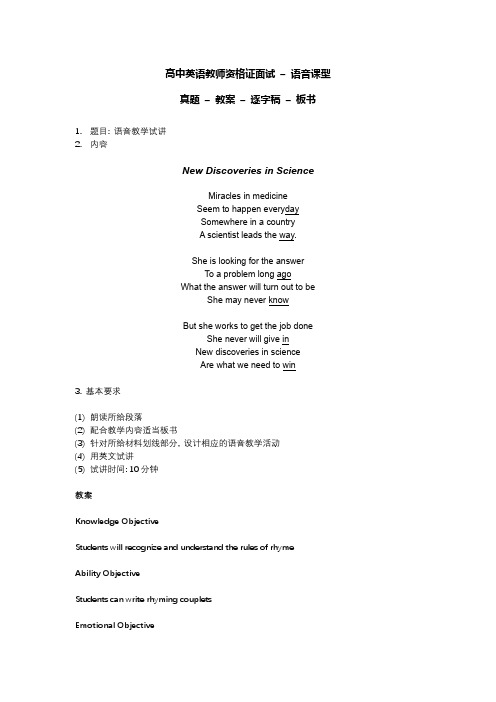
高中英语教师资格证面试–语音课型真题–教案–逐字稿–板书1.题目: 语音教学试讲2.内容New Discoveries in ScienceMiracles in medicineSeem to happen everydaySomewhere in a countryA scientist leads the way.She is looking for the answerTo a problem long agoWhat the answer will turn out to beShe may never knowBut she works to get the job doneShe never will give inNew discoveries in scienceAre what we need to win3. 基本要求(1)朗读所给段落(2)配合教学内容适当板书(3)针对所给材料划线部分, 设计相应的语音教学活动(4)用英文试讲(5)试讲时间: 10分钟教案Knowledge ObjectiveStudents will recognize and understand the rules of rhymeAbility ObjectiveStudents can write rhyming coupletsEmotional ObjectiveStudents get interested in appreciating English poemsTeaching Key and Difficult Points:Key Point – Students get to understand the rules of rhymeDifficult Point – Students are able to write rhyming coupletsTeaching Method3P (Presentation – Practice – Production)Teaching ProcedureLead-inHave a quick review on rules of stress with studentsPresentation1.The teacher reads the poem and students try to get the main idea of the poem2.The teacher reads the poem again and have students recognize something in commonof the underlined words3.The teacher explains the rules of rhymePractice1.Students read the poem to their elbow partners and then the teacher invite some of themto read the poem in front of the whole class2.The teacher reads some rhyming couplets and asks students which words are rhymed Presentation1.Students work in groups and try to write rhyming couplets2.The teacher invites students to read their rhyming coupletsSummaryThe teacher helps students to summarize what they have learned in classHomeworkStudents write a short poem with rhyming couplets and hand it in tomorrow逐字稿(Greeting)Good morning, boys and girls. How are you doing today? Great? Glad to hear that. If you are ready, let’s begin our class.(Lead-in)Last week, we studied rules of stress. So, let’s have a quick review first. Michael, do we need to place stress on a one-syllable word? (Michael…) Exactly, Michael, thank you. We always place stress on a one-syllable word. Then Nina, what about a two-syllable word?(Nina…) Good job. Thank you, Nina. The first syllable is usually stressed when it comes to a two-syllable word, like “custom” and “many”. Jenny, what words are often stressed in a sentence? (Jenny…) Thank you, Jenny, you’re right. Content words such as verbs, nouns, adjectives are usually stressed. Leo, what words are not stressed in a sentence?(Leo…) Thank you, Leo. Yes, we don’t place stress on structure words like articles, conjunctions and prepositions. Excellent. You guys did a fantastic job last week.(Presentation)Today we are still going to learn some rules about pronunciation. Now I’ll read you a poem. After that, I would like you to tell me what this poem is about. Now please listen to the poem.Well, Cynthia, what is this poem about? (Cynthia…). Exactly, Cynthia, thank you. Of course, this poem is about new discoveries in science. Now everyone please open your book and turn to page five. I’ll read it again and this time I would like you guys to pay special attention to the underlined words. Then you can have a discussion with your elbow partner on what things in common these words have in terms of pronunciation. Now, I’ll read the pome again. Please listen carefully. (The teacher read the poem.) Well, you can start discussing with your elbow partner. Here we go.T ime’s up. Alex, do you find something in common among the underlined words? (Alex…). Thank you, Alex. You’re quite perceptive. They have same sounds in the final syllables which usually include a vowel sound, like “day” and “way”, “ago” and “know”, “in” and “win”. People refer to this phenomenon as rhyme in English. As to pairs of lines that end in words that rhyme, people refer to them as rhyming couplets.(Practice)N ow, I’ll give you 3 minutes to read the poem by yourselves. Then I’ll invite some of you to read the poem. Let’s begin.Time’s up. Billy, can you read the poem for us?(Billy…) Great job, Billy. Thank you.Now, I’ll read you some rhyming couplets. After that, I would like you to tell me the rhyming words in them. Here we go.Terry, what are the rhyming words in the couplet I just read? (Terry…) Thank you, Terry. Well done. “Cat” and “Hat” are the rhyming words.(Presentation)N ow, It’s time you write some rhyming couplets. You need to work with your elbow partner and write two rhyming couplets. You have 5 minutes. Let’s begin.T ime’s up. Amy, could you share your couplets with us?(Amy…) Thank you, Amy. Fantastic job there.(Summary)N ow let’s have a quick recap. Sunny, can tell me what is rhyme? (Sunny…). Thank you, Sunny. And Derek, what is a rhyming couplet? (Derek…). Exactly. Thank you, Derek.(Homework)Let’s call it a day. As for the homework, you need to write a short poem with rhyming couplets and hand it in tomorrow. Thank you for your time, boys and girls. Have a good day.板书RhymeDay – Way /ei/Ago – Know /nəʊ/In – Win /in/。
初中英语教资面试-语音课+写作课备课稿
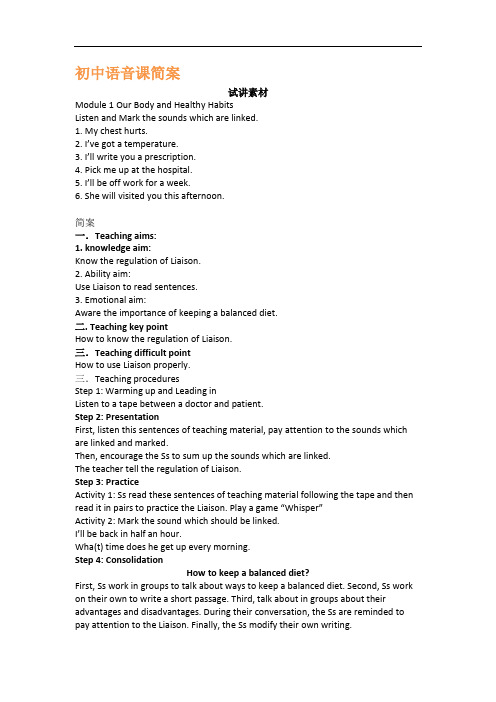
初中语音课简案试讲素材Module 1 Our Body and Healthy HabitsListen and Mark the sounds which are linked.1. My chest hurts.2. I’ve got a temperature.3. I’ll write you a prescription.4. Pick me up at the hospital.5. I’ll be off work for a week.6. She will visited you this afternoon.简案一.Teaching aims:1. knowledge aim:Know the regulation of Liaison.2. Ability aim:Use Liaison to read sentences.3. Emotional aim:Aware the importance of keeping a balanced diet.二. Teaching key pointHow to know the regulation of Liaison.三.Teaching difficult pointHow to use Liaison properly.三.Teaching proceduresStep 1: Warming up and Leading inListen to a tape between a doctor and patient.Step 2: PresentationFirst, listen this sentences of teaching material, pay attention to the sounds which are linked and marked.Then, encourage the Ss to sum up the sounds which are linked.The teacher tell the regulation of Liaison.Step 3: PracticeActivity 1: Ss read these sentences of teaching material following the tape and then read it in pairs to practice the Liaison. Play a game “Whisper”Activity 2: Mark the sound which should be linked.I’ll be back in half an hour.Wha(t) time does he get up every morning.Step 4: ConsolidationHow to keep a balanced diet?First, Ss work in groups to talk about ways to keep a balanced diet. Second, Ss work on their own to write a short passage. Third, talk about in groups about their advantages and disadvantages. During their conversation, the Ss are reminded to pay attention to the Liaison. Finally, the Ss modify their own writing.Step 5: SummaryThe Ss summarize what we have learnt, and the teacher help to complete. Step 6: HomeworkReview what we have learnt.Talk about how to lead a healthy life with their partners in English.初中写作课简案一、Teaching Objectives教学目标1. 1) Master the format/features of letter.2) Review some words about friendship and communication.2. Write a letter about how to keep a good relationship with friends.3. Getting alone well with their classmates or friends.二.Teaching key pointsMaster the features of letters.三.Teaching difficult pointsEnable Ss to write a letter in proper structure.四、Teaching proceduresStep 1: Warming up & Leading inFirstly, show students the letter.T: what’s the features abou t it? And having a discussion.BrainstormStep 2 Pre-writing1. Ss sum up the features of letter, teacher supplement.address, body and signature.2. GeneratingChoose useful information.3. PlanningStructureStep 3 while-writing1. Fast writing2. Group discussion3. ModificationStep 4: Post-writing1. Share your writing2. Writing assessment(1) Can you organize your ideas in logical way?(2) Have you made brainstorm map before writing? Do you think it helpful? Step 5 HomeworkWrite a letter about describing oncoming Spring Festival to your foreign friend Grace.。
2023年12月高中英语教资面试真题教案逐字稿 高中英语语音课-语调
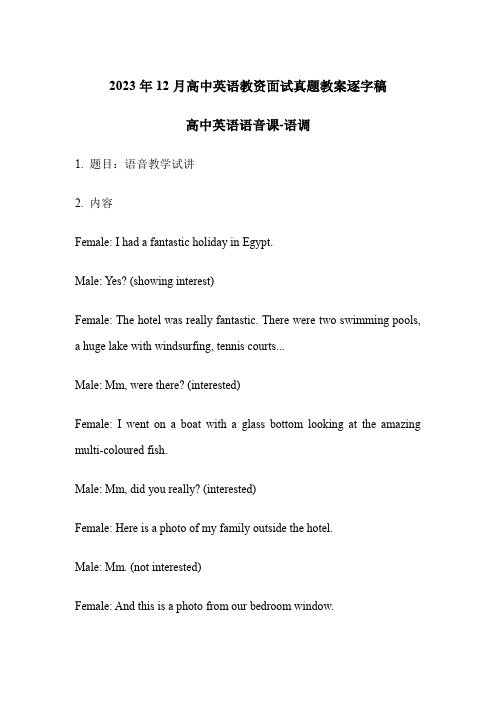
2023年12月高中英语教资面试真题教案逐字稿高中英语语音课-语调1. 题目:语音教学试讲2. 内容Female: I had a fantastic holiday in Egypt.Male: Yes? (showing interest)Female: The hotel was really fantastic. There were two swimming pools, a huge lake with windsurfing, tennis courts...Male: Mm, were there? (interested)Female: I went on a boat with a glass bottom looking at the amazing multi-coloured fish.Male: Mm, did you really? (interested)Female: Here is a photo of my family outside the hotel.Male: Mm. (not interested)Female: And this is a photo from our bedroom window.Male: Yes? (totally uninterested)3. 基本要求:(1) 朗读所给对话。
(2) 配合教学内容适当板书。
(3) 针对所给材料内容,设计关于语调的教学活动。
(4) 用英文试讲。
(5) 试讲时间:10分钟。
教案English Intonation in ConversationsObjectives:1. To understand the role of intonation in English conversations.2. To identify and practice different types of intonation.3. To apply intonation effectively in casual conversations. Materials Used:1. Copies of the conversation.2. Audio recordings of different intonations.3. Visual aids (pictures, graphs).Methodology:Introduction:Intonation is the rise and fall of the voice, which changes the meaning of a sentence. It is a crucial aspect of communication, especially in English, where intonation can significantly alter the intended meaning of a sentence.Activity 1:Students will listen to the given conversation and identify the intonation patterns used by the speakers. They will be asked to mark the rises and falls in the voice.Activity 2:Students will be shown different visual aids (graphs, pictures) that represent different intonation patterns. They will be asked to identify each pattern and its typical use in casual conversations.Activity 3:Students will practice different intonation patterns by reciting sentences with each pattern. They will be encouraged to use different rises and falls in their voices while reciting the sentences.Activity 4:Students will role-play the given conversation, using the intonation patterns they have just practiced. They will be asked to make their voices rise and fall appropriately, based on the content of their sentences. Conclusion:Students will be asked to reflect on the role of intonation in communication. They will be encouraged to apply what they have learned in casual conversations with their peers.Assessment:Assessment will be based on students' ability to identify and use different intonation patterns effectively in their role-plays. Feedback will be provided on their performance, focusing on improvements needed in their intonation usage.逐字稿Introduction to English IntonationGood morning/afternoon, everyone! Today, we’re going to explore an important aspect of language that adds depth and meaning beyond the words themselves: intonation.Intonation, or the rise and fall of the voice, is a crucial element of communication. In English, it’s not just about the words you use; it’s about the way you use your voice to convey your message. Think of intonation as a form of non-verbal communication, much like facial expressions or body language.Types of Intonation1. Flat Intonation:When the voice remains at the same pitch throughout a sentence, it’s known as flat intonation. This is often used for statements or when the speaker is being matter-of-fact.2. Rising Intonation:As the name suggests, the pitch rises at the end of a sentence or phrase. This is often used for questions or statements that require confirmation.3. Falling Intonation:The pitch falls at the end, often indicating a statement of fact or a completed thought.Functions of Intonation1. Emphasis:Intonation can highlight certain words or phrases, adding emphasis to them. For example, in the sentence "I love _cookies_!" the intonation on "cookies" would likely be higher, emphasizing that particular word.2. Meaning Modification:The same sentence can have different meanings depending on the intonation used. For instance, "I love you" can mean "I am in love with you" or simply "I am fond of you," depending on the intonation pattern used.3. Emotional Expression:Intonation is also a key indicator of emotions. A rising intonation at the end of a sentence can indicate surprise, curiosity, or uncertainty, while a falling intonation might indicate disappointment or resignation. Practice and Tips1. Listen and Imitate:The best way to learn intonation is by listening to native speakers and imitating their patterns. Watch movies or TV shows with English subtitles to hear how native speakers use intonation.2. Record and Review:Use voice recording apps to record yourself speaking English and then review the recording. Pay attention to your intonation patterns and identify areas for improvement.3. Practice with Friends:Have a friend help you practice by reciting lines from movies or scripts and focusing on your intonation. They can give feedback on your patterns and suggest improvements.4. Consistency:It’s important to be consistent with your intonation patterns, as inconsistency can confuse listeners and dilute your message. Practice regularly to ensure consistency in your speech.Remember, intonation is a learned skill that takes time and practice to master. Don’t be too hard on yourself; every step forward is a step in theright direction!That’s it for today’s lesson on English intonation! I hope you’ ve found it informative and helpful. Remember to practice regularly and you’ll soon see improvements in your English communication skills. Thank you for listening!。
江西教师招聘面试高中英语说课稿子:《Advertising》

江西教师招聘面试高中英语说课稿子:《A d v e r t i s i n g》work Information Technology Company.2020YEAR江西教师招聘面试高中英语说课稿:《Advertising》Greeting:Good morning, dear judges. It’s my pleasure to be here to share my teaching ideas with you. Today based on the students-oriented teaching principle, I will talk about my reaching ideas from the following aspects: the analysis of teaching material and students, teaching objectives, teaching key and difficult points, teaching procedures and so on.1 Analysis of teaching materialsThis lesson is chosen from Unit 1, Module 4 Advance with English. It is the grammar part of this unit and focus on how to change direct speech into reported speech. It is useful for students to talk about others’ opinion on a certain topic and also lay a foundation for students to learn noun clauses. Meanwhile, in the text book, there has already been the details of the changing. So in this lesson, I need to present more examples to help students to understand the details more deeply.2 Analysis of studentsMy students are in the first year of senior high school. Having learned English for seven years, students have a basic knowledge of English expression. But they need to learn more accurate expression, especially some grammar knowledge to further English study. However, students in this stage are active, curious and innovative, they may dislikethe rigid unintelligible grammar rules. So students will be the host of the class and try to conclude the rules by themselves.3 Analysis of teaching aimsAccording to the idea of New Curriculum Standard in English, I set the following teaching objectives:First is knowledge aims.(1). Students can explain the difference of direct speech and reported speech.(2). Students can list the changes when transform the direct speech into reported speech.Second is ability aims:(1). Students can use reported speech or indirect speech to report things.(2). Students can express others’ ideas more properly.The last is emotional aims:Students can be more confident in learning English.4 Analysis of teaching key points and difficult pointsBased on the teaching aims, here are the key points and difficult points.Key points:How to change direct speech into reported speech.Difficult Points:Students can express their opinions on whether students should attend tutorial centers or not.5 Analysis of teaching methods and learning methodsIn this lesson I’ll mainly use “Task-based teaching method”, “Inductive teaching method” and “CAI teaching method”. As to the studying methods, I will encourage students to use cooperative study method to embody the role of first place in instruction activities.6 Analysis of teaching aidsEffective teaching aids are also inseparable in this class, I will use multi-media to help students achieve better understanding.7 Analysis of teaching proceduresThis is the most important part in this design, it can be divided into following steps:Step 1 Warming-upAt the beginning of the class, I will present a short video. It is a joke about XiaoMing. He misuses I, she and he, and can’t introduce his family members to others properly. After watching the video, I will ask students why others laugh at Xiao Ming and I am sure students will be curious about how to report others’ words. Today’s topic how to change direct speech into reported speech will be leaded naturally. Meanwhile, students’ interest will be aroused and a nice atmosphere will be created for this lesson.Step 2 PresentationIn this step, I will ask students to watch several advertisements. In every videos there is a person to talk about the merits of his or her products. Then I will list several sentences on the PPT. For example:1. The girl said that she was praised by her boyfriend.2. The boy introduce that the little guys can be found wherever they are.3. A lot of mums encourage others to use it to protect babies skin.And ask students to choose which advertisement it refers to. By reading the sentences, students can easily get the answer and choose the right pictures. Then I will show the original sentences, that is, the direct speech of the advertisement and the listed sentences before together. Ask students to observe the sentences and try to think about what is the direct speech and reported speech and how to change direct speech into reported speech. Students can discuss it with their partners and present their answers. By discussing, the whole class can finally draw the conclusion that: we can change direct speech into reported speech by using an object clause or an infinitive phrase.After students get the basic points of changing, I will go on presenting several reported speech chosen from the advertisements and ask students to pay attention to the form of different reported speech including statements, questions and imperative statements. Byobserving and explaining, students can understand three basic rules of reported speech:1. Noun clauses introduced by that can be used to report statements. The word that can be omitted.2. Noun clauses introduced by whether/if can be used to reportyes/no questions.3. Structure: reporting verb+object+(not)+to infinitive can be used to report imperative sentences.After students learn some basic forms of reported speech, I will show some sentences using direct speech and ask students to try to change them into reported speech. After all the students finish it, I will underline the personal pronouns, tense, time and place, pronoun in these sentences and ask students to check their deskmates’ sentences again and pay attention to the underline parts.After students checking, I will present the sentences students made and ask them to conclude the important points of changing a direct speech into reported speech from the following aspects: personal pronouns, tense, time and place, pronoun and other special cases.Advertisement is the topic of this unit. After learning the reading part, students has already been familiar with the topic, so I use the advertisement to lead in different sentences using direct speech and reported speech to help them accept the new grammar rules moreeasily. Inductive method and deductive method are combined in this part to achieve students’ mastership.Step 3 PracticeIn this part, Students will practice the grammar rules under real situation. I will design mechanical exercise and meaningful exercise to help them pay attention to the key and difficult points of this grammar.I will set a situation for students to practice the grammar. The whole class is an advertisement department. Every student is a member of the department. They are asked to finish the following tasks.1. There is a report made by their colleague and students need to find mistakes and correct the sentences on the blackboard.2. I will show the advertisement of the text book and ask students to complete the letter written by Wang Yilin to Mr Fan Zhenbin. Then check the answer with their classmates.3. Show a list of tips given by an advertising expert and ask them to report the advice to the manager and finish the Exercise B in P11.By completing the above exercise, students can get a deeper understanding of the grammar and the key point and difficult point will be solved in this step.Step 4 Post-readingIn this step, I will lead students fully cooperate with each other and learn how to use what they learned into their daily life.I will ask four students to make up a group and finish the following tasks.1. Show a short video and encourage students to talk about the story of the video with each other.2. Set a situation to the students: There is an advertisement order about useful English learning method. Invite students to discuss it in groups and list the opinions of every group members and then change the opinions with the group beside by using reported speech. Then some volunteers will be invited to share their opinions and get some praise.Step 5 Summary and homeworkThe last step is summary and homework. I will invite students conclude what they have learned in this lesson and emphasize the key points of changing a direct speech into reported speech.Then I will ask students to choose one of their favorite films and try to retell the most excellent episode of the film by using reported speech.All the above work is to train students analysis ability and learning strategies. They will learn that summary and continuous practice while learning is one of the most effective methods of learning.8 Blackboard designThe main information is demonstrated on the blackboard and its logic is clear.Thank you for you listening.。
初中英语教师资格面试-语音课教案+讲课+板书模板

初中英语教资面试语音课双元音教学案Lessen plan for the pronunciation of ________Teaching aims:(1)Knowledge aim: be able to know how to pronounce the diphthong ________(2)Ability aim: By the end of the class, students should be able to pronounce the diphthong(记着此处换词)________(3)Emotion aim: be able to pronounce the ________more confidentlyTeaching methods: 3-P modelTeaching aids: chock, blackboard, some cardsTeaching procedure:PronunciationStepⅠGreeting and Lead-in(回答完评委的两个结构化问题,不要再想了!开始上课吧!自己站在讲桌后,右手压左手,自然摆放在腰带扣的地方,也就是肚脐眼的地方,告诉自己放松,再放松!双手越自然越好!气定神怡,平心静气,微笑对评委以及评委身后那不存在还要假装存在的学生,说:)T: Class begins. Good morning/afternoon, boys and girls. Nice to have this English class with you. Today we are going to learn a diphthong(记着此处换词)in English.StepⅡPresentation ⅡShow some cards to the students. Lead in the diphthong(记着此处换词)________T: first,I will show pictures on the blackboard. Do you know, what is this in English?S: this is a________.T: yes, very good. This is a________. Now read after me,________.S:________T:________S:________T: OK, very good. Then the second one, what is this in English?S: this is a ________.T: good. This is a ________. And what is she doing now?S: she is crying.T: so in her eyes, there are ……S: ________T: excellent! There are ________ in her eyes. Read after me. ________S: ________T: ________S: ________T: Ok. Now, another picture, what is this in English?S: this is ________.T: you are great. This is a bottle of ________. Now read after me, ________S: ________T: ________S: ________T: Ok. We have learned these three words:________, ________ and ________. From these words, can you find something in common?S: they all have the sound ________StepⅢPractice ⅢPractice the students the sound ________, and explain the right way to pronounce the sound.T: yes, very good. These words all contain the sound________. Now read after me, ________ /S: ________。
教师资格证考试-面试-高中英语-教案模板+逐字稿-语音课
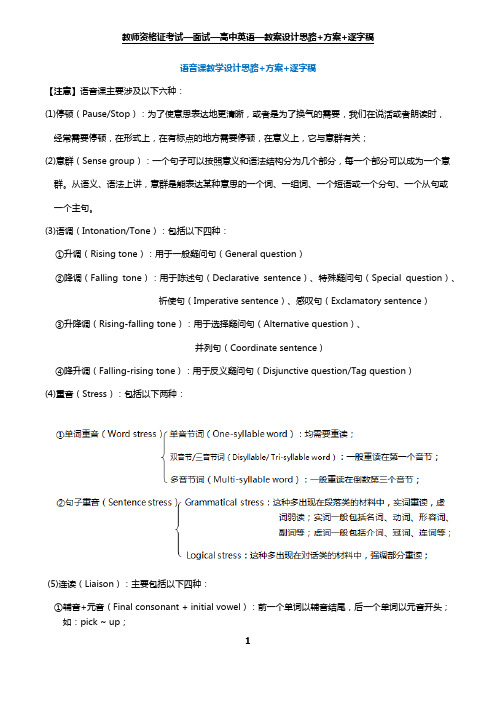
语音课教学设计思路+方案+逐字稿【注意】语音课主要涉及以下六种:(1)停顿(Pause/Stop):为了使意思表达地更清晰,或者是为了换气的需要,我们在说活或者朗读时,经常需要停顿,在形式上,在有标点的地方需要停顿,在意义上,它与意群有关;(2)意群(Sense group):一个句子可以按照意义和语法结构分为几个部分,每一个部分可以成为一个意群。
从语义、语法上讲,意群是能表达某种意思的一个词、一组词、一个短语或一个分句、一个从句或一个主句。
(3)语调(Intonation/Tone):包括以下四种:①升调(Rising tone):用于一般疑问句(General question)②降调(Falling tone):用于陈述句(Declarative sentence)、特殊疑问句(Special question)、祈使句(Imperative sentence)、感叹句(Exclamatory sentence)③升降调(Rising-falling tone):用于选择疑问句(Alternative question)、并列句(Coordinate sentence)④降升调(Falling-rising tone):用于反义疑问句(Disjunctive question/Tag question)(4)重音(Stress):包括以下两种:(5)连读(Liaison):主要包括以下四种:①辅音+元音(Final consonant + initial vowel):前一个单词以辅音结尾,后一个单词以元音开头;如:pick ~ up;②r/re+元音(r/re + initial vowel):前一个单词以r/re结尾,后一个单词以元音开头;如:for ~example;③元音+元音(Final vowel + initial vowel):前一个单词以元音结尾,后一个单词以元音开头;如:how ~ are you?④辅音+辅音(Final consonant + initial consonant):前一个单词以辅音结尾,后一个单词以辅音开头;后面的辅音实际上是半元音(semi-vowel);如:luck ~ you;(6)爆破(Plosive):主要包括以下四种:①失去爆破(Loss of plosive):当2个爆破音相连时,第一个“引而不发”,第二个爆破;爆破音包括:/b/ /p/ /d/ /t/ /g/ /k/ ;如:doctor;②不完全爆破(Incomplete plosive):当爆破音后面跟有摩擦音(/f/ /v/ /θ/ /ð/ /s/ /z/ /ʃ/ /ʒ//h/)、破擦音(/tʃ/ /dʒ/)时,前面的爆破音只做部分爆破;如:good friends;③/t/ 或 /d/ + /m/ 或 /n/ 型:如:good morning;④/t/ 或 /d/ + /l/ 型:handle;【设计思路】语音课,我们采用3P模式,即presentation, practice以及production;各个环节可以设计的活动如下:【教案】Teaching PlanTeaching Aims:Knowledge aims:(1)Students can know the meaning of …(语音现象)in English language studying.(2)Students can learn …(材料内容)Ability aims:(根据语音现象选择)①停顿/意群:Students can pause correctly according to the sense group in reading sentences.②语调:Students can recognize different intonations of different sentences, such as declarative sentence, general question.③重读:Students can understand the intention of speaker and the changes of meaning through the changes of stress.④连读:Students can read the sentences more fluently by using the knowledge of liaison.⑤爆破:Students can read English sentences more fluently by using the knowledge of loss of plosive.Emotional aims: (以下内容选一/二即可)(1)Students can get more interests and confidence in learning English.(2)Students will be willing to apply their English into daily use.(3)Students can get the awareness of cooperation with others.Teaching Key & Difficult Points:Teaching key point:Students can know what …(语音现象)is and how to use it.Teaching difficult point:How to make students understand what …(语音现象) is.Teaching Procedures:Step 1 Warming up1.Greetings.2.Lead-in: (以下导入方式选其一即可)①Review the knowledge that we learned before/in the last class with the students: …②Check students’ homework that I assigned in the last class: …③Share a story/saying/experience with students: …④Show students some pictures about … and ask them to think about the following questions:/ Play a short video to the students and ask them to think about the following questions during watching:Q1: …Q2: …⑤Free talk: ask students to discuss the following question and then invite some of them to share their answers:Q: …⑥Tongue twister: read one/some tongue twisters twice for the students and ask them which time is better and why.Tongue twisters: How many cookies could a good cook cook if a good cook could cook cookies?Can you can a can as a canner can can a can?(读的时候,第一遍可以不是很好,第二遍要又快又准,并且要用到材料中所涉及的语音现象;提供的绕口令要与语音现象有关;)Step 2 Presentation(1)Deal with the material: (以下方式取其一即可)①Play the tape once or twice, ask students to get the main idea of it or just ask them one or two questions:Q1: …Q2: …(以上是将材料作为听力材料所设计的活动;若文章要求朗读文章,此步骤可设计成教师朗读;若材料比较简单,可以只听一遍)②Read the passage once or twice, ask students to get the main idea of it or just ask them one or two questions:Q1: …Q2: …(以上是将材料作为阅读材料所设计的活动;若文章要求朗读文章,此步骤可设计成教师朗读;若材料比较简单,可以只读一遍)(2)根据语音现象从以下中选择:①停顿/意群:Read the passage for the students, then ask them “how many stops are there in my reading?”②语调:Read the passage for the students and read some new sentences twice, then ask them “what’s the difference of these two times?”③重音:Read the passage for the students and read some new sentences twice, then ask them “what’s the difference of these two times?”④连读:Read the passage for the students and read some new sentences twice, then ask them “which time is better and why?”⑤爆破:Read the passage for the students and read some new sentences twice, then ask them “what’s the difference of these two times?”(3)Make a summary about the rules of …(语音现象)Step 3 PracticeAsk the students to read the passage with the rules of …(语音现象), then invite some of them to share and give evaluation.Step 4 ProductionPlay a dubbing game: play a short video and then ask students to play a dubbing game.Step 5 Summary and HomeworkSummary: ask a student/lead the students to summarize the content of this lesson.(总结环节可以是老师自己总结,让同学总结,老师和同学一起总结三种方式,一般使用后两种方式比较好)Homework: ask students to write a short passage about … and make a record of their reading with the rules of …(语音现象) and emotion.Blackboard design:【试讲逐字稿】[自我介绍]:Good morning/afternoon, dear judges, I’m No.X candidate applying for high school English teacher. (有的地方不让说姓名,只能说号码,但有的地方规定要说姓名,进入面试室时,有人会给你看一下注意事项,所以请一定看清,否则说错了会视为作弊,取消资格的)(上面这一句是在敲门得到允许进去后,所做的自我介绍,或者是向考官问好,一般考官会回应说:good morning/afternoon,之后你需要走到讲台上,进行结构化答题,回答结束后,考官会说请开始你的试讲)分割线—下面是真正的试讲逐字稿Today my topic is …, now I’ll start my class.[Greetings]:Class begins, sit down please. Good morning/afternoon, boys and girls, welcome to my class. How are you guys today? Great? Not bad? Glad to hear that. Me? Oh I’m pretty good, thanks for your asking. So are you ready for our class? Ok, good.[Lead-in]:以下方式选其一即可(建议在此步骤中,若能与文章标题联系起来的时候,可以书写板书:具体的标题,若文章没有标题,可以找机会一边说:today we’re going to have a reading class, 一边书写板书:reading)①Before our class, boys and girls, let’s have a quick review about what we learned in the last class. Do you still remember it? Great, you all remember it. Yes, we learned about …. Now as for today we are going to learn more about it/we are going to learn another grammar.②Before our class, boys and girls, do you still remember the task that I assigned for you in the last class? Yes, it is … Ok, so how many of you have prepared it? Show me your hands. Ok Anna, please. (此处停顿几秒,假装Anna在回答)Excellent, I can see you did it with your heart. Now as for today, we are going to learn …/we are going to talk more about …③-1.Before our class, boys and girls, I’d like to share a story with you. After the story, you need to tell me …(此处可以出一个问题)So please listen to me carefully. …(讲故事)So who wants to share your answers with us? Anna, please. …(Anna的回答)Very good, sit down, please. Now as for today, we are going to learn …/we are going to talk more about …③-2.Before our class, boys and girls, I have s sentence for you, please listen to me carefully and please try to guess its meaning …(此处讲一个名人名言)So who wants to share your answers with us? Anna, please. …(Anna的回答)Very good, sit down, please. Now as for today, we are going to learn …/we are going to talk more about …③-3.Before our class, boys and girls, I’d like to share one experience of mine with you …(讲经历)So how about you? Do you have any unforgettable experience? Anna, please share with us. …(Anna的回答)Very good, sit down, please. Now as for today, we are going tolearn …/we are going to talk more about …④Before our class, boys and girls, let’s watch a short video/some pictures, and you need to think about the following questions: Q1: … and Q2: … Are you clear? Ok, great, let’s start here.(观看视频/图片,停顿几秒)Well you have enjoyed the video/the pictures, have you got the answers? Anna, you please. Oh you think … Yes, great, sit down please. How about question 2? Peter, please have a try. You think … I agree with you, sit down please. Now as for today, we are going to learn …/we are going to talk more about …⑤Before our class, boys and girls, I’d like to ask you a question: … Anna, please have a try. Yeah, …(Anna的回答)Wonderful, thank you, sit down please. And? Peter, please. Great, …(Peter的回答)Now as for today, we are going to learn …/we are going to talk more about …⑥Before our class, boys and girls, I have a tongue twister for you. Please listen to me carefully. …(绕口令)and please think about one question: why do you think tongue twister can be spoken so smoothly and quickly? Uh huh, yes, we can speak two or three words in a way of connecting. Good point, and in English, we call it liaison. Now as for today, we are going to learn more about it. (此处是以连读为例)[Presentation]:(1)以下方式选其一即可:①Now let’s listen to the tape. Please listen carefully and try to catch the main idea of it /try to think about the following one/two questions:Q1: …Q2: …Are you clear? Start here.(停顿几秒)It’s over, so have you got the main idea of it? Good, it’s … Very good.②Now let’s take out our paper and look at the reading passage. Please read it carefully to catch the main idea of it/to think about the following one/two questions:Q1: …Q2: …Are you clear? Start here.(停顿几秒)It’s over, so have you got the main idea of it? Good, it’s … Very good.(2) 以下方式选其一即可:①停顿/意群:Ok, now guys, I’ll read the passage for you again, and this time, please focus on my reading, and try to figure out where I stop when I’m reading. You can make notes if necessary, and at last, you need to tell me how many stops in the passage. …(教师朗读文章)Ok, how many stops do you found? Lily you please. …(Lily的回答)Good, sit down please. Do you agree with her? Yes? Very good.②语调:Ok, now guys, I’ll read the passage for you again, and this time, please focus onmy reading, and try to figure out some differences among some sentences. …(教师朗读文章,若没有要求,可以省略)Now it’s time to learn something new. Let’s look at a new sentences. I’ll read it twice, then please tell me the difference of these two times, clear? Ok, …(读两遍)Ok, can you tell me the difference of them? Please discuss it with your partner, then share with us, ok? Good, start.(停顿几秒)Who wants to share? Ok, Lily you please. You used different tones. Good, you got the point, sit down, please.③重音:Ok, now guys, I’ll read the passage for you again, and this time, please focus onmy reading, and try to figure out some differences among some sentences. …(教师朗读文章,若没有要求,可以省略)Now it’s time to learn something new. Let’s look at a new sentences. I’ll read it twice, then please tell me the difference of these two times, clear? Ok, …(读两遍)Ok, can you tell me the difference of them? Please discuss it with your partner, then share with us, ok? Good, start.(停顿几秒)Who wants to share? Ok, Lily you please. You emphasized different words each time. Good, you got the point, sit down, please.④连读:Ok, now guys, I’ll read the passage for you again, and this time, please focus onmy reading, and try to figure out some differences among some sentences. …(教师朗读文章,若没有要求,可以省略)Now it’s time to learn something new. Let’s look at a new sentences. I’ll read it twice, then please tell me which time is better, clear? Ok, …(读两遍)Which one is better? The second time? Ok, can you tell me why the second time is better? Please discuss it with yourpartner, then share with us, ok? Good, start.(停顿几秒)Who wants to share? Ok, Lily you please. Because you speak “…” and “…” in a way of connecting. Good, you got the point, sit down, please.⑤失爆:Ok, now guys, I’ll read the passage for you again, and this time, please focus onmy reading, and try to figure out some differences among some sentences. …(教师朗读文章,若没有要求,可以省略)Now it’s time to learn something new. Let’s look at a new sentences. I’ll read it twice, then please tell me the difference of these two times, clear? Ok, …(读两遍)Ok,can you tell me the difference of them? Please discuss it with your partner, then share with us, ok? Good, start.(停顿几秒)Who wants to share? Ok, Lily you please. You didn’t speak the letter “…” in the word of “…” in the second time. Good, you got the point, sit down, please.(3) 以下方式选其一即可:①停顿/意群:Actually in English, we call it “pause”(此时可以书写板书:what is pause?). Now I am wondering what the rules of pause are? Now please work in groups of four to discuss about it. You will have 5 minutes, clear? Ok, start.(停顿几秒,此时可以书写板书:when should we use pause?)Ok, time’s up. So have you found the rules? Well your group think that we should pause when we meet “and ”, “but”, “however”, “that”, “which” etc, and your group think that we should pause when we meet phrases and clauses. Very good. Let’s summarize the rules together. Actually we can say that we should pause in sense groups. So what is sense groups? A sense group is a language group that share the same meaning. That is to say, in a sentence, every word has its own meaning, and when they are combined together, they have a different meaning. When you pause at any word, it cannot convey the complete meaning of the sentence. Then we call it a sense group, clear? Great.②语调:Actually in English, we call it “intonation” or “tone”(此时可以书写板书:what is intonation?). Now I am wondering what the rules of intonation are? Now please work in groups of four to discuss about it. You will have 5 minutes, clear? Ok, start.(停顿几秒, 此时可以书写板书:when should we use intonation?)Ok, time’s up. So have you found the rules? Well, let’s summarize it together. We use rising tone in general questions, falling tone in declarative sentences, special questions, imperative sentences and exclamatory sentences. We use rising-falling tone in alternative questions, and coordinate sentences. For example, in an alternative question, there are two parts, we use rising tone for the first part, and falling tone for the second part. And we use falling-rising tone in disjunctive questions. For example, in an disjunctive question, there are two parts, we use falling tone for the first part, and rising tone for the second part. Clear? Great.③重音-1:单词重音:Actually in English, we call it “ word stress”(此时可以书写板书:what is word stress?). Now I am wondering what the rules of it are? Now please work in groups offour to discuss about it. You will have 5 minutes, clear? Ok, start.(停顿几秒, 此时可以书写板书:when should we use word stress?)Ok, time’s up. So have you found the rules? Well, let’s summarize it together. For one-syllable words, we need to stress them, for disyllable or try-syllable words, normally we need to stress on the first syllable, and for multi-syllable words, we need to stress on the antepenultimate syllable. Clear? Great.③重音-2:句子重读-Grammatical stress:Actually in English, we call it “grammatical stress”(此时可以书写板书:what is grammatical stress?). Now I am wondering what the rules of it are? Now please work in groups of four to discuss about it. You will have 5 minutes, clear? Ok, start.(停顿几秒, 此时可以书写板书:when should we use grammatical stress?)Ok, time’s up. So have you found the rules? Well, let’s summarize it together. Normally, we stress the notional words not the functional words. And notional words include nouns, verbs, adjectives, adverbs, etc,. and functional words include prepositions, article, adjunction, interjection, etc,. Clear? Great.③重音-3:句子重读-Logical stress:Actually in English, we call it “logical stress”(此时可以书写板书:what is logical stress?). Now I am wondering what the rules of it are? Now please work in groups of four to discuss about it. You will have 5 minutes, clear? Ok, start.(停顿几秒, 此时可以书写板书:when should we use logical stress?)Ok, time’s up. So have you found the rules? Well, let’s summarize it together. Normally, we highlight or stress the information that the speaker or someone wants to know. Clear? Great.④连读:Actually in English, we call it “liaison”(此时可以书写板书:what is liaison?). NowI am wondering what the rules of it are? Now please work in groups of four to discuss about it. You will have 5 minutes, clear? Ok, start.(停顿几秒, 此时可以书写板书:when should we use liaison?)Ok, time’s up. So have you found the rules? Well, let’s summarize it together. Normally, we can say the structure is: Final consonant + initial vowel, which means the first word is ended with a consonant and the second one is beginning with a vowel, such as pick ~ up./Final letter r/re + initial vowel, which means the first word is ended with the letter of r/re, and the second one is beginning with a vowel, such as for ~ example. /Final vowel + initial vowel, which means the first word is ended with a vowel and the second one is beginning with a vowel, such as how ~ are you? /Final consonant + initial consonant, which means the first word is ended with a consonant and the second one is beginning with a consonant, such as luck ~ you.(一般材料中只会涉及一种形式,请根据材料选择相应的形式) Clear? Great.⑤爆破:Actually in English, we call it “loss of plosive”(此时可以书写板书:what is loss of plosive?). Now I am wondering what the rules of it are? Now please work in groups of four to discuss about it. You will have 5 minutes, clear? Ok, start.(停顿几秒, 此时可以书写板书:when should we use loss of plosive?)Ok, time’s up. So have you found the rules? Well, let’s summarize it together. There are six plosives: /b/ /p/ /d/ /t/ /g/ /k/, when any two of them meet, for the first one, you just give the shape of the mouth, do not need to give any sound of it. Such教师资格证考试—面试—高中英语—教案设计思路+方案+逐字稿as: doctor. /There are six plosives: /b/ /p/ /d/ /t/ /g/ /k/, and when any of them is followed with a fricative (/f/ /v/ /θ/ /ð/ /s/ /z/ /ʃ/ /ʒ/ /h/) or affricative (/tʃ/ /dʒ/), for the plosive, you just give a slight sound. Such as: good friend. /When /t/ or /d/ is followed with /m/ or /n/ or /l/, for /t/ or/d/, you just give the shape of the mouth, do not need to give any sound of it. Such as: good morning. (一般材料中只会涉及一种形式,请根据材料选择相应的形式) Clear? Great.[Practice]:Practice makes perfect. So let’s do some exercises. Please read the passage again. This time, you need to use the rules of …(语音现象)and then we’ll invite some of you to share with us, clear? Ok, start here.(停顿几秒)Now time’s up, who want to have a try? Lucy you please. (不需真正回答,只需停顿几秒,然后直接点评即可)Good, you did a good job, but there’s still some little mistakes. …(改正)Clear? Good, sit down please. Another one? Peter, please have a try.(不需真正回答,只需停顿几秒,然后直接点评即可)Well done, you made no mistake, sit down, please.[Production]:Since we mastered the knowledge well, let’s play a dubbing game, we will watch a movie, for the first time, listen to it carefully, and the second time, it’ll be silent, you need to choose your own character and try to make the scene as interesting as you can, please try to use the rules of …(语音现象)that we just learned, then we’ll have some students to share, clear? Good, start.(停顿几秒)Time’s up. Group one, please share your performance with us. (不需真正回答,只需停顿几秒,然后直接点评即可)Excellent, you all give a wonderful performance. I’m very proud of your progress and smart ideas.[Summary and homework]:How time flies! It’s time to make a summary. Let’s do it together. Today we havelearned … Yes, very good, and the rules of it are …. Ok good, we all did a good job in this class.(老师带领大家一起回答时,当说到重点的时候,要有所停顿,因为我们需要做的是引导学生回答,而不是我们自己回答)Well, after class, I’d like you to write a short passage about … and make a record of your reading with what we learned today. Are you clear? Ok, great. That’s all for today’s class. Goodbye class, see you next time.[结尾]:That’s all for my presentation, thank you![接下来就是答辩]11。
2024教师招聘面试高中英语词汇逐字稿
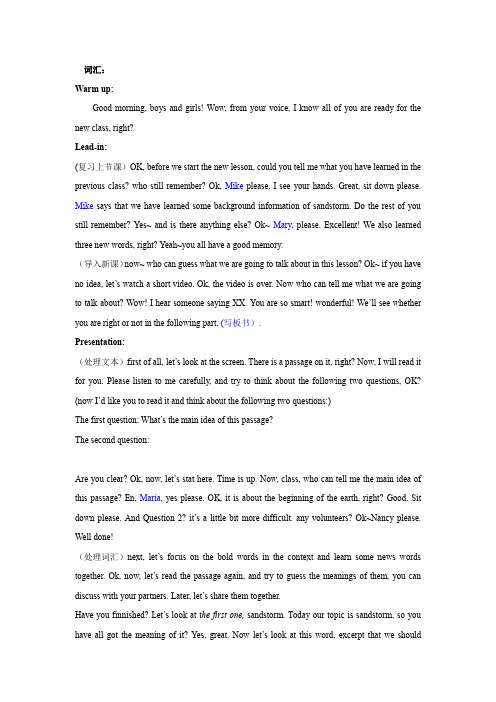
词汇:Warm up:Good morning, boys and girls! Wow, from your voice, I know all of you are ready for the new class, right?Lead-in:(复习上节课)OK, before we start the new lesson, could you tell me what you have learned in the previous class? who still remember? Ok, Mike please, I see your hands. Great, sit down please. Mike says that we have learned some background information of sandstorm. Do the rest of you still remember? Yes~ and is there anything else? Ok~ Mary, please. Excellent! We also learned three new words, right? Yeah~you all have a good memory.(导入新课)now~ who can guess what we are going to talk about in this lesson? Ok~ if you have no idea, let’s watch a short video. Ok, the video is over. Now who can tell me what we are going to talk about? Wow! I hear someone saying XX. You are so smart! wonderful! We’ll see whether you are right or not in the following part. (写板书).Presentation:(处理文本)first of all, let’s look at the screen. There is a passage on it, right? Now, I will read it for you. Please listen to me carefully, and try to think about the following two questions, OK? (now I’d like you to read it and think about the following two questions:)The first question: What’s the main idea of this passage?The second question:Are you clear? Ok, now, let’s stat here. Time is up.Now, class,who can tell me the main idea of this passage? En, Maria, yes please. OK, it is about the beginning of the earth, right? Good. Sit down please. And Question 2? it’s a little bit more difficult. any volunteers? Ok~Nancy please. Well done!(处理词汇)next, let’s focus on the bold words in the context and learn some news words together. Ok, now, let’s read the passage again, and try to guess the meanings of them, you can discuss with your partners. Later, let’s share them together.Have you finnished? Let’s look at t he first one, sandstorm. Today our topic is sandstorm, so you have all got the meaning of it? Yes, great. Now let’s look at this word, excerpt that we shouldknow the meaning of it, we all need o know the word formation of it. Actually, it it a ...yes, compound words. It is combined with sand and storm. So when so much sand meet together, there will be a storm, and we call it sandstorm. Clear? Good.And the second word, forecast. Can you figure out the word formation by taking the first word as an example? Besides, try to find out the synonym of it in the following context. You can discuss with your partner. Have you done? Ok, let’s answer it together. The word forecast is combined with....yes, “fore” and “cast” in English, we call “fore” a prefix, which defines the meaning of this word. Ok, and the synonym of this word in this context is....yes, predict.Ok, the third word. For this word, can you try to guess the meaning of it from the context? Yes, you are so clear. I’ll do the action and you an see whether your guessing is right or not. Yes, great. It’s an adjective. And the noun from is breath, while the verb form is breathe. Are you clear? Practice:now, let’s do some exercise to consolidate the three new words.①(翻译或造句子)The first activity: let’s do some translation: translate the following sentences into English/let’s make some sentences using the new words.沙尘暴已经成了十大自然灾害之一。
教师招聘、教师资格证面试小学英语《语音教学》试讲稿
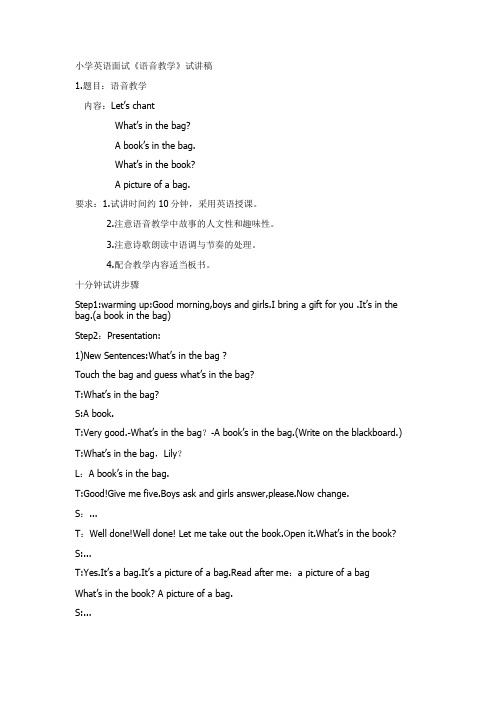
小学英语面试《语音教学》试讲稿1.题目:语音教学内容:Let’s chantWhat’s in the bag?A book’s in the bag.What’s in the book?A picture of a bag.要求:1.试讲时间约10分钟,采用英语授课。
2.注意语音教学中故事的人文性和趣味性。
3.注意诗歌朗读中语调与节奏的处理。
4.配合教学内容适当板书。
十分钟试讲步骤Step1:warming up:Good morning,boys and girls.I bring a gift for you .It’s in the bag.(a book in the bag)Step2:Presentation:1)New Sentences:What’s in the bag ?Touch the bag and guess what’s i n the bag?T:What’s in the bag?S:A book.T:Very good.-What’s in the bag?-A book’s in the bag.(Write on the blackboard.) T:What’s in the bag,Lily?L:A book’s in the bag.T:Good!Give me five.Boys ask and girls answer,please.Now change. S:...T:Well done!Wel l done! Let me take out the book.Open it.What’s in the book? S:...T:Yes.It’s a bag.It’s a picture of a bag.Read after me:a picture of a bag What’s in the book? A picture of a bag.S:...T:You are so great!In order to reward you,here's a chant /a song for you. Do you want to learn it?(询问的眼神)Oh,yes! Let's listen to the tape first.(自己绘声绘色的演绎一遍)Is it difficult?(询问)No.It's so easy for you .OK,follow the tape. How clever you are. Who wants to try? John,please .(手势)Very good,sit down please.2)More wordsWho can tell me what’s in the bag?(put Ss’s pencil/pencil box,ruler...in the bag) Step3:ConsolidationGroup work:1)T:Now four students in one group ,you have 10 minutes,one ask and the other three answer then change,ok?Later we will invite two groups to s how to us.Let’s start.(前后两步做巡视状)Time’s up.Which group wants to show?Ok, this group.Good job!Next? Youfour ,please.Very good!Give me five.Step4:Summary and homeworkT:Let’s chant together.What’s in the bag?A book’s in the bag.What’s in the book?A picture of a bag.What’s in the bag?Pens,pencils,pens and pencils.Are you happy in this class? Will you tell this chant to your parents?S:yes.T: See you next class.。
教师资格证面试小学英语语音课模板

小学英语语音课模板Warm up and lead inGood morning, my class. What’s the weather today? It’s so good! And the sky is so blue. Are you happy to see the blue sky? Yes? OK, let’s sing a_____ song. Three, two, one, go!... wow, your voices are so loud and beautiful. And I can see that you are really happy.PresentationThis class, I bring you some pictures. Let’s look at the picture. What is it? yes a______, yes. it must be yummy. You mouths must be watering. So this is a cake.(板书). Now look at this picture. what’s on it? A___? Yes, a _____. We can see that the boy has a round…face. Good. Face.(板书) Touch your faces now. let’s me see your hands on your faces. Good. You all know the meaning of it. Next picture. what’s on it? Still a boy. But can you see other things? scissors? A book and a glue. And he is…making something. So here’s the word. Make.(板书)。
初中英语教学法面试语音课逐字稿

初中英语教学法面试语音课逐字稿本文档是一份面试语音课的逐字稿,目的是为了展示初中英语教学法的能力和技巧。
以下是面试课的具体内容和教学方法。
课堂介绍本节课重点教授英语的语音知识,主要包括发音、音标和语调。
课程时长约为40分钟。
课程目标- 培养学生正确的英语发音惯- 研究基础音标和常见发音规则- 提高学生的听力和口语能力教学流程1. 课堂开场:用简单的英语问候学生,引起学生的兴趣和注意。
2. 导入活动:播放一段短语音材料,让学生跟读。
通过听和模仿提高学生的发音准确度。
3. 音标介绍:使用课件或黑板展示基础音标,逐个介绍其发音规则和示范。
让学生跟读音标,并纠正他们的发音错误。
4. 练活动:设置一些发音练,如搭配练、语调练等。
鼓励学生积极参与,建立自信心。
5. 板书总结:将学过的音标和发音规则整理在黑板上,供学生复和记忆。
6. 结束活动:与学生互动,进行简单的问答或小游戏,巩固所学内容并营造良好的课堂氛围。
教学策略- 融合任务型教学法和互动式教学法,使学生在实践中掌握和运用所学知识。
- 使用多媒体资源和示范,帮助学生更好地理解和模仿正确发音。
- 培养积极的研究氛围,让学生愿意参与课堂活动,提高研究效果。
教学评估- 通过观察学生的发音和参与度来评估其研究成果。
- 可以设置一些听力和口语练,检验学生对所学知识的掌握情况。
参考资料- 外语教学与研究出版社(Foreign Language Teaching and Research Press)出版的初中英语教材和教学指南。
以上是初中英语教学法面试语音课的逐字稿。
通过本节课的教学内容和方法,我们可以帮助学生掌握正确的发音并提高听力和口语能力。
希望能获得面试机会,以展示更多的教学能力和经验。
谢谢!。
应聘英语教师面试—听力课型实战篇--精致讲稿
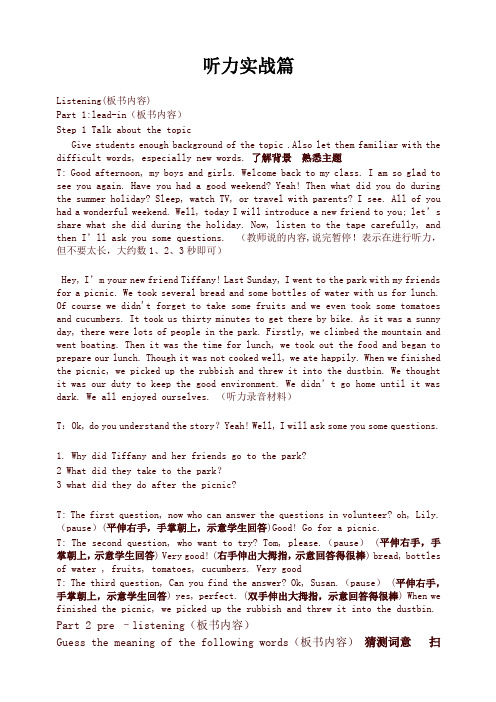
听力实战篇Listening(板书内容)Part 1:lead-in(板书内容)Step 1 Talk about the topicGive students enough background of the topic .Also let them familiar with the difficult words, especially new words.了解背景熟悉主题T: Good afternoon, my boys and girls. Welcome back to my class. I am so glad to see you again. Have you had a good weekend? Yeah! Then what did you do during the summer holiday? Sleep, watch TV, or travel with parents? I see. All of you had a wonderful weekend. Well, today I will introduce a new friend to yo u; let’s share what she did during the holiday. Now, listen to the tape carefully, and then I’ll ask you some questions. (教师说的内容,说完暂停!表示在进行听力,但不要太长,大约数1、2、3秒即可)Hey, I’m your new friend Tiffany! Last Sunday, I went to the park with my friends for a picnic. We took several bread and some bottles of water with us for lunch. Of course we didn't forget to take some fruits and we even took some tomatoes and cucumbers. It took us thirty minutes to get there by bike. As it was a sunny day, there were lots of people in the park. Firstly, we climbed the mountain and went boating. Then it was the time for lunch, we took out the food and began to prepare our lunch. Though it was not cooked well, we ate happily. When we finished the picnic, we picked up the rubbish and threw it into the dustbin. We thought it was our duty to keep the good environment. We didn’t go home until it was dark. We all enjoyed ourselves. (听力录音材料)T:Ok, do you understand the story?Yeah! Well, I will ask some you some questions.1. Why did Tiffany and her friends go to the park?2 What did they take to the park?3 what did they do after the picnic?T: The first question, now who can answer the questions in volunteer? oh, Lily.(pause)(平伸右手,手掌朝上,示意学生回答)Good! Go for a picnic.T: The second question, who want to try? Tom, please.(pause) (平伸右手,手掌朝上,示意学生回答) Very good! (右手伸出大拇指,示意回答得很棒) bread, bottles of water , fruits, tomatoes, cucumbers. Very goodT: The third question, Can you find the answer? Ok, Susan.(pause) (平伸右手,手掌朝上,示意学生回答) yes, perfect. (双手伸出大拇指,示意回答得很棒) When we finished the picnic, we picked up the rubbish and threw it into the dustbin. Part 2 pre –listening(板书内容)Guess the meaning of the following words(板书内容)猜测词意扫清障碍Now, you have understood the story well. Let’s look at the details of the text.① phasesFirst of all, let’s look at the phrases in the text.1 Go for a picnic. Have food outdoors2 By bike it’s an important phrase.“B y” plus transport is the meaning of taking transport.For exampleBy bike/train/bus/ship/airplane/foot, no, it is on foot, not by foot.3 pick up take sth upI picked up the money on the ground.Ok so much for the phrases.②important sentences1. It took us thirty minutes to get there by bike.The sentence instruction is :It takes/took sb some time to do sth.And the question sentence of this instruction is:How long does/did it take sb to sth.For example: How long does it take you to go home?It usually takes me 20minutes to go home.Who can make a sentence?T: Don’t be shy, just have a try.(环顾四周)Tom, do you want to have a try? (Pause)OK!How long does it take you to go to school?Yes, great! It takes me half an hour to go to school. Great, sit down please. 2The next sentence is:We didn’t go until it was dark. The sentence instruction is :not until .what’s the meaning of the phrase?直到...才。
英语老师教招讲课稿范文
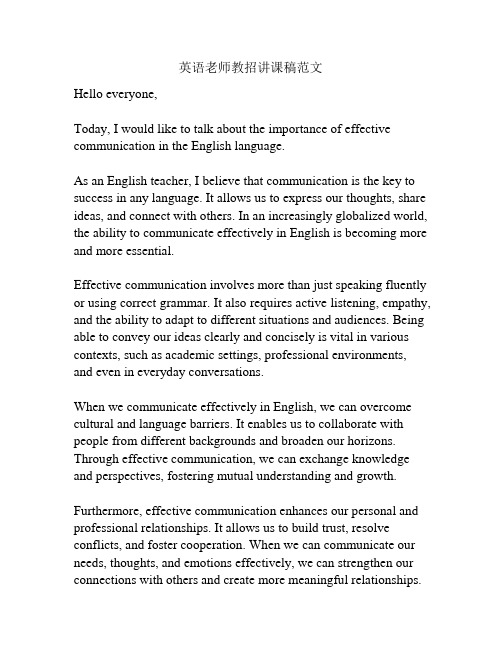
英语老师教招讲课稿范文Hello everyone,Today, I would like to talk about the importance of effective communication in the English language.As an English teacher, I believe that communication is the key to success in any language. It allows us to express our thoughts, share ideas, and connect with others. In an increasingly globalized world, the ability to communicate effectively in English is becoming more and more essential.Effective communication involves more than just speaking fluently or using correct grammar. It also requires active listening, empathy, and the ability to adapt to different situations and audiences. Being able to convey our ideas clearly and concisely is vital in various contexts, such as academic settings, professional environments, and even in everyday conversations.When we communicate effectively in English, we can overcome cultural and language barriers. It enables us to collaborate with people from different backgrounds and broaden our horizons. Through effective communication, we can exchange knowledge and perspectives, fostering mutual understanding and growth. Furthermore, effective communication enhances our personal and professional relationships. It allows us to build trust, resolve conflicts, and foster cooperation. When we can communicate our needs, thoughts, and emotions effectively, we can strengthen our connections with others and create more meaningful relationships.To improve our communication skills in English, it is essential to practice regularly. Engaging in conversations, participating in discussions, and seeking feedback from others are all effective ways to enhance our abilities. Additionally, reading books, watching movies or TV shows, and listening to podcasts in English can help us expand our vocabulary and understanding of the language.In conclusion, effective communication is crucial in mastering the English language. It opens doors to countless opportunities, facilitates cultural exchange, and enhances our personal and professional relationships. Let us strive to improve our communication skills in English so that we can succeed in an increasingly interconnected world.Thank you for your attention!。
- 1、下载文档前请自行甄别文档内容的完整性,平台不提供额外的编辑、内容补充、找答案等附加服务。
- 2、"仅部分预览"的文档,不可在线预览部分如存在完整性等问题,可反馈申请退款(可完整预览的文档不适用该条件!)。
- 3、如文档侵犯您的权益,请联系客服反馈,我们会尽快为您处理(人工客服工作时间:9:00-18:30)。
教师招聘英语面试语音课型实战篇Document number【SA80SAB-SAA9SYT-SAATC-SA6UT-SA18】语音课型四色笔讲稿模板红色字体为板书内容蓝色字体为设计目的黑色字体为口述内容绿色字体为提示内容双元音教学案Lessen plan for the pronunciation of /i/Teaching aims:(1)Knowledge aim: be able to know how to pronounce the diphthong /i/(2)Ability aim: By the end of the class, students should be able to pronounce the diphthong/i/(3)Emotion aim: be able to pronounce the /i/more confidentlyTeaching methods: 3-P model(Presentation, Practice, Production)Teaching aids: chock, blackboard, some cardsTeaching procedure:Pronunciation(板书内容)StepⅠGreeting and Lead-in(回答完评委的两个结构化问题,不要再想了!开始上课吧!自己站在讲桌后,右手压左手,自然摆放在腰带扣的地方,也就是肚脐眼的地方,告诉自己放松,再放松!双手越自然越好!气定神怡,平心静气,微笑对评委以及评委身后那不存在还要假装存在的学生,说:)T: Class begins. Good morning/afternoon, boys and girls. Nice to have this English class with you. Today we are going to learn a diphthong in English. StepⅡ PresentationShow some cards to the students. Lead in the diphthong /i/T: first,I will show some cards. Do you know, what is this in EnglishS: this is a deer.T: yes, very good. This is a deer. Now read after me, deer.S: deerT: deerS: deerT: OK, very good. Then the second one, what is this in EnglishS: this is a girl.T: good. This is a girl. And what is she doing nowS: she is crying.T: so in her eyes, there is ……S: tearsT: excellent! There are tears in her eyes. Read after me. TearS: tearT: tearT: Ok. Now, another picture, what is this in EnglishS: this is beer.T: you are great. This is a bottle of beer. Now read after me, beerS: beerT: beerS: beerT: Ok. We have learned these three words: deer, tear and beer. From these words, can you find something in commonS: they all have the sound /i/StepⅢ Practice ⅢPractice the students the sound /i/, and explain the right way to pronounce the sound.T: yes, very good. These words all contain the sound/i/. Now read after me, /i/ /S: /i/T: /i/S: /i/T: /i/S: /i/T: Ok, very good. Now who can pronounce the sound Cuqi, you, pleaseS: /i/T: /i/, read after me.S: /i/.T: yes, very good. Lyly, can youS: /i/.T: OK Good. Xixi, pleaseS: /i/T: yes, very good.S: /i/T: OK, excellent. Now, the whole class read after me. /i/S: /i/T: /i/S: /i/T: good. Now, do you know the right way to pronounce the diphthong /i/S: no.T: this is a diphthong. It begins with the first sound /i/,( write the /i/ on the blackboard) and glide towards the second sound //,( write the // on the blackboard) remember, when you pronounce the Zhaozhao . You, please. diphthong/i/, you should change the shape of your mouth as you move from one sound to another. Now, / look at the position of my lips when I pronouncethis sound. /i/, /i/, /i/. Now read after me, /i/S: /i/.S: /i/.T: /i/.S: /i/T: very good. Now, I will divide you into two groups. Group 1 read the sound three times, and then group 2. Are you clearS: Yes.T: /i/. One two go.S: /i/ /T: very good. Now group2S:/i You all have done a good job. Now let’s do some exercise of sound discrimination. Listen to me carefully and circle the words which contain the sound /i/from each of the following pairs. , peer pearS: peer, the first one.T: excellent. , tare tearS: the second one.T: are you sureS: yes.T: OK, very good. dareS: the first one.T: great! mere mareS: mere, the fist one.T: you are so smart. Now, please look at the blackboard. There is a tongue twister. Who can read it out Miky, you, please.S: a deer and a mare spare mere one second to drink a bottle of beer without tears.T: very good. A deer and a mare spare mere one second to drink a bottle of beer without tears. And who would like to trycuqi, please.S: a deer and a mare spare mere one second to drink a bottle of beer without tears.T: excellent!StepⅤ SummarizeT: today, we have learned the sound /i/; remember the right way to pronounce this sound. It begins with the first sound /i/ and glide towards the second sound //, you should practice more after class.StepⅥ HomeworkPractice the diphthong /i/ with your partner.2013真题舌侧音(Lateral)舌尖顶住上齿向外弹出同时声带震动所发的音例如清晰型:[ l ] : letter lesson lowThe tip of the tongue against the upper teeth popped out at the same time, vocal cord vibration sound made by such as clear type: [l]: letter lesson low 含糊型:[ l ] :ball school bottleVague type "looks l]: Ball School Bottle舌尖顶住上齿龈,让气流从舌头两边通过,所以叫舌侧音。
The tip of the tongue against the upper gum, make the air flow through the sides of the tongue, so called tongue side tone.清晰B: OK, lunch is ready.A: What’s for lunch, MumB: We’ll have lamb and potato salad.A: Marvelous! I love salad.含糊/l/出现在辅音前或词尾如:belt, small, apple, table 等。
